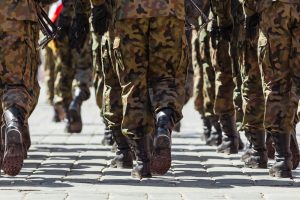
Army Basic Training, also known as Basic Combat Training (BCT), is the initial training program for recruits in the United States Army. It’s a challenging and transformative experience that prepares soldiers for their future roles in the Army. Here’s an overview of what to expect:
Phase 1: Red Phase (Weeks 1-3)
- Initial Processing: Recruits arrive at the training base and undergo initial processing, which includes medical screenings, haircuts, and uniform issues.
- Drill and Ceremony: Recruits learn the basics of drill and ceremony, including marching, uniforms, and military protocol.
- Physical Fitness: Recruits begin their physical fitness training, which includes push-ups, sit-ups, and 2-mile runs.
- Core Values: Recruits learn about the Army’s core values, including loyalty, duty, respect, selfless service, honor, integrity, and personal courage.
-
How to Prepare for Army Basic Training Physically and Mentally
Embarking on the journey of Army basic training requires both physical endurance and mental readiness. Here’s how you can prepare yourself to meet the challenges ahead:
Physical Preparation
- Build Your Strength: Incorporate strength training into your routine. Focus on exercises like push-ups, sit-ups, and squats to develop your core and upper body strength.
- Cardiovascular Fitness: Running is an essential part of military training, so gradually increase your running distance and speed. Aim for a consistent running schedule to build stamina.
- Flexibility and Endurance: Activities like yoga or pilates can improve your flexibility, which will help prevent injuries. Include endurance exercises such as cycling or swimming to enhance your overall fitness.
Mental Preparation
- Knowledge Acquisition: Familiarize yourself with basic military knowledge. Learn about ranks, the phonetic alphabet, and Army values to ease communication and understanding during training.
- Mental Resilience: Basic training is demanding, so practice stress-relief techniques like meditation or mindfulness to improve resilience under pressure.
- Discipline and Routine: Establish a daily routine similar to what you’ll face in training. Waking up early and following a structured schedule can help you adapt more easily.
Balance and Rest
- Healthy Diet: Ensure you’re eating a balanced and nutritious diet to fuel your body and speed up recovery.
- Adequate Rest: Never underestimate the power of sleep. Proper rest is crucial for physical recovery and mental clarity.
By focusing on these areas, you’ll not only ready your body for the physical demands but also arm yourself with the mental tools necessary to thrive during Army basic training.
Find Your Nearest Military Recruiter Here?
Phase 2: White Phase (Weeks 4-6)
- Combat Skills: Recruits learn basic combat skills, including marksmanship, first aid, and combat tactics.
- Map Reading: Recruits learn to read maps and navigate using a compass.
- Field Training: Recruits participate in field training exercises, which simulate real-world combat scenarios.
- Team Building: Recruits learn to work together, building camaraderie and trust.
Phase 3: Blue Phase (Weeks 7-10)
- Advanced Combat Skills: Recruits learn advanced combat skills, including hand-to-hand combat, rappelling, and obstacle course training.
- Simulation Training: Recruits participate in simulation training mimicking real-world combat scenarios.
- Final Exam: Recruits take a final exam to test their knowledge and skills.
- Graduation: Recruits graduate from Basic Training and become soldiers in the United States Army.
- The Significance of Army Basic Training Graduation
Army Basic Training Graduation marks a pivotal transformation in the lives of those who have endured one of the toughest challenges of their lives. It symbolizes not just the completion of a rigorous training regimen but also a profound personal metamorphosis.
For weeks, these individuals have tested their mental and physical endurance to the limits, fostering discipline, tenacity, and respect. The culmination of their hard work is celebrated on graduation day, a highly anticipated event that represents the shift from civilian life to becoming a committed member of the military.
Why Graduation Matters
- Recognition of Achievement: Graduation is a formal acknowledgment of the trainees’ dedication and perseverance. It validates the countless hours of training and the sacrifices made along the way.
- A New Identity: Beyond the celebration, this ceremony signifies the moment recruits embrace their new roles as Soldiers. It’s a rite of passage that marks their official entry into the armed forces.
- Family and Community: Loved ones gather to witness this profound change, offering support and sharing in the pride and joy. Their presence underscores the communal aspect of military life and the importance of a support network.
Graduation day is not just an end—it’s a commencement into a career of service and honor, setting the stage for future contributions to national defense and the embodiment of the values instilled during training.
Daily Life in Basic Training:
- Reveille: The day begins at 5:30 a.m. with reveille, followed by physical fitness training.
- Breakfast: Recruits eat breakfast in the dining facility.
- Training: Recruits attend training classes and participate in field training exercises.
- Lunch: Recruits eat lunch in the dining facility.
- Training: Recruits attend additional training classes and participate in field training exercises.
- Dinner: Recruits eat dinner in the dining facility.
- Evening Routine: Recruits participate in evening routine activities, including cleaning their barracks and preparing for the next day.
Army Basic Training, also known as Basic Combat Training (BCT), is the initial training program for new recruits in the United States Army. The length of Army Basic Training can vary depending on several factors, including the type of training and the individual’s Military Occupational Specialty (MOS).
Understanding Mail in Army Basic Training
During Army basic training, receiving mail is an important morale booster for recruits. Here’s a quick guide on how the mail system works and what you can expect:
- Mail Call Excitement: Each day, there’s a designated time known as “mail call” when letters are distributed. This is often the highlight of the day for trainees, providing them with encouraging words from loved ones.
- Keeping in Touch:
Friends and family can send handwritten letters, which is a traditional but heartfelt way to connect. It’s advisable to send them frequently, as these updates provide crucial emotional support during training.- Package Restrictions:
While letters are always welcome, packages are subject to specific rules. Trainees might not be able to receive certain items like snacks or electronics, so it’s important for senders to know what’s allowed.- Using Digital Solutions:
There are also digital platforms available that can make communication quicker by delivering printed letters more efficiently. These services often provide options for including photos or other small printed extras, adding a personal touch.- Timeliness and Consistency:
Mail delivery can be slightly delayed due to the location and nature of the training environment. Consistently sending letters every week or every few days can help bridge any gaps caused by these delays.In summary, while the traditional mail system may seem slow, it’s a crucial component of staying connected during basic training. Knowing the guidelines and using a combination of methods can ensure that recruits remain motivated and in touch with their support systems back home.
Where Are the Army Basic Training Locations?
Army basic training takes place at four primary locations across the United States. Which location you’ll attend often depends on your designated job or Military Occupational Specialty (MOS). Here’s a closer look at where you’ll potentially start your journey:
- Fort Benning: Nestled in Columbus, Georgia, Fort Benning is renowned for its infantry and armor training programs. It’s where you might find yourself if your MOS aligns with these specialties.
- Fort Leonard Wood: Situated in the scenic Missouri Ozarks, this location is the training ground for those entering engineering, chemical, and military police specialties.
- Fort Sill: Located in Lawton, Oklahoma, Fort Sill is primarily focused on field artillery training. Choose this location and brace yourself for the precision and teamwork of artillery.
- Fort Jackson: As the largest basic combat training facility, Fort Jackson is in Columbia, South Carolina. Recruits from various specialties start their military careers here.
Each of these locations offers a unique environment and challenges, preparing recruits for the diverse demands of military life.
Advanced Individual Training (AIT):
After completing Basic Training, recruits attend Advanced Individual Training (AIT) to learn the skills specific to their MOS. AIT can last from a few weeks to several months, depending on the complexity of the job. Soldiers will not get to return home after graduation; instead, they will head directly to their assigned AIT location. The location depends on their MOS, and some may remain at the same base as their Basic Training, while others will have up to two days to travel to a new base.
One Station Unit Training (OSUT):
Certain MOSs, such as Infantry and Armor, require a longer training period. One Station Unit Training (OSUT) combines Basic Training and AIT into a single, continuous training program that can last up to 22 weeks. Soldiers who undergo OSUT will receive orders upon completion and proceed directly to their first duty station, bypassing the separate AIT process.
Specialized Training:
In addition to AIT and OSUT, some recruits may require further specialized training, which includes:
- Airborne School: 3 weeks
- Ranger School: 62 days
- Special Forces Assessment and Selection (SFAS): 24 days
- Language Training: varies depending on the language and level of proficiency
These programs are designed to equip soldiers with advanced skills that are critical for specific roles within the Army.
In Summary:
The length of Army Basic Training can vary from 10 weeks to several months, depending on the individual’s MOS and specialized training requirements.
